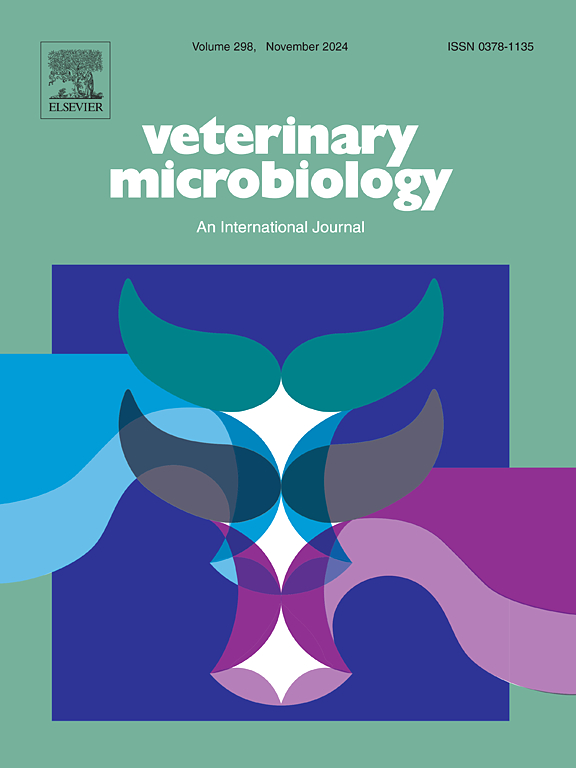Prevalence of tick-borne pathogens in grey wolves (Canis lupus) in southwestern Europe
IF 2.4
2区 农林科学
Q3 MICROBIOLOGY
引用次数: 0
Abstract
In Europe, studies on tick-borne pathogens (TBPs) in wolves are limited, primarily focusing on one population. This study aimed to assess the prevalence of TBPs in grey wolves (Canis lupus) from Spain (n = 129), Italy (n = 113), and Portugal (n = 43) between 2001 and 2023. The presence of Anaplasma spp., Ehrlichia spp., Hepatozoon spp. and piroplasm DNA was analyzed in spleen samples, and risk factors for Hepatozoon canis prevalence were evaluated using a generalized linear model. Overall, 93.3 % (266/285) wolves tested positive to at least one TBP, being H. canis the most prevalent (91.6 %). Babesia canis (1.8 %), Anaplasma phagocytophilum (1.4 %), and Babesia capreoli (0.7 %) were detected in small percentages and Ehrlichia spp. and Theileria spp. were not found. Coinfections involving H. canis + B. canis (1.8 %) as well as A. phagocytophilum + B. capreoli (0.4 %) were detected. Hepatozoon canis prevalence was significantly higher in Spain than in Portugal and it was higher in young compared to subadult individuals. The phylogenetic analysis showed the existence of well-defined clades of H. canis. The high prevalence of H. canis indicates that this pathogen is endemic in wolves from these three countries, whereas the importance of Anaplasma, Ehrlichia and piroplasm species seems to be negligible. Our results show a high nucleotide diversity among the H. canis sequences. In addition, our data reveals that wolves from the study countries are infected with TBPs, which could be of health concern. These findings highlight the importance of performing epidemiological studies in wildlife.
欧洲西南部灰狼(Canis lupus)中蜱传病原体的流行
在欧洲,对狼的蜱传病原体(tbp)的研究有限,主要集中在一个种群上。本研究旨在评估2001年至2023年间西班牙(n = 129)、意大利(n = 113)和葡萄牙(n = 43)灰狼(Canis lupus) tps的患病率。分析脾脏样本中无原体、埃利希体、肝虫和肝质DNA的存在情况,并采用广义线性模型评估犬肝虫流行的危险因素。总体而言,93.3 %(266/285)的狼至少对一种TBP检测呈阳性,其中犬属最普遍(91.6 %)。检出犬巴贝斯虫(1.8 %)、嗜吞噬细胞无形体(1.4 %)和卡氏巴贝斯虫(0.7 %),未检出埃利希氏体和希勒氏菌。涉及犬H. + 的共感染(1.8 %)以及嗜吞噬细胞A. + B.;检出Capreoli(0.4 %)。犬肝虫病的流行率在西班牙明显高于葡萄牙,并且在年轻人中的流行率高于亚成年个体。系统发育分析表明,犬属存在明确的分支。犬支原体的高流行率表明这种病原体在这三个国家的狼中是地方性的,而无形体、埃利希体和梨质体物种的重要性似乎可以忽略不计。我们的研究结果表明,在犬人序列中具有很高的核苷酸多样性。此外,我们的数据显示,来自研究国家的狼感染了tbp,这可能是健康问题。这些发现突出了在野生动物中进行流行病学研究的重要性。
本文章由计算机程序翻译,如有差异,请以英文原文为准。
求助全文
约1分钟内获得全文
求助全文
来源期刊

Veterinary microbiology
农林科学-兽医学
CiteScore
5.90
自引率
6.10%
发文量
221
审稿时长
52 days
期刊介绍:
Veterinary Microbiology is concerned with microbial (bacterial, fungal, viral) diseases of domesticated vertebrate animals (livestock, companion animals, fur-bearing animals, game, poultry, fish) that supply food, other useful products or companionship. In addition, Microbial diseases of wild animals living in captivity, or as members of the feral fauna will also be considered if the infections are of interest because of their interrelation with humans (zoonoses) and/or domestic animals. Studies of antimicrobial resistance are also included, provided that the results represent a substantial advance in knowledge. Authors are strongly encouraged to read - prior to submission - the Editorials (''Scope or cope'' and ''Scope or cope II'') published previously in the journal. The Editors reserve the right to suggest submission to another journal for those papers which they feel would be more appropriate for consideration by that journal.
Original research papers of high quality and novelty on aspects of control, host response, molecular biology, pathogenesis, prevention, and treatment of microbial diseases of animals are published. Papers dealing primarily with immunology, epidemiology, molecular biology and antiviral or microbial agents will only be considered if they demonstrate a clear impact on a disease. Papers focusing solely on diagnostic techniques (such as another PCR protocol or ELISA) will not be published - focus should be on a microorganism and not on a particular technique. Papers only reporting microbial sequences, transcriptomics data, or proteomics data will not be considered unless the results represent a substantial advance in knowledge.
Drug trial papers will be considered if they have general application or significance. Papers on the identification of microorganisms will also be considered, but detailed taxonomic studies do not fall within the scope of the journal. Case reports will not be published, unless they have general application or contain novel aspects. Papers of geographically limited interest, which repeat what had been established elsewhere will not be considered. The readership of the journal is global.
 求助内容:
求助内容: 应助结果提醒方式:
应助结果提醒方式:


